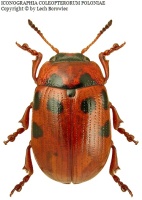Підтримуємо Вільну Україну
 We Support Free Ukraine
We Support Free Ukraine

Biodiversity Map
Taxa

Gonioctena — subordinate taxa:
Taxon count: 8
-
Gonioctena arcticaSet as tree root ↑
Show taxon data → → Show taxon data -
Gonioctena decemnotataSet as tree root ↑
Show taxon data → ⚑
 [90] → Show taxon data
[90] → Show taxon data -
Gonioctena flavicornis flavicornisSet as tree root ↑
Show taxon data → ⚑ [28] → Show taxon data
[28] → Show taxon data -
Gonioctena holdhausiSet as tree root ↑
Show taxon data → → Show taxon data -
Gonioctena kaufmanniSet as tree root ↑
Show taxon data → → Show taxon data -
Gonioctena linnaeana linnaeanaSet as tree root ↑
Show taxon data → ⚑ [65] → Show taxon data
[65] → Show taxon data -
Gonioctena nivosaSet as tree root ↑
Show taxon data → → Show taxon data -
Gonioctena viminalis viminalisSet as tree root ↑
Show taxon data → ⚑
 [111] → Show taxon data
[111] → Show taxon data
-
Arthropodaphylum
Click to switch
to select orders
and filters > -
Hexapodasubphylum
Click to switch
to select orders
and filters > -
Insectaclass
Click to switch
to select orders
and filters > -
Coleopteraorder
Click to set
as the main taxon
and as a base
← of the left panel > -
Polyphagasuborder
Click to set
as the main taxon
and as a base
← of the left panel > -
Cucujiformiaseries
Click to set
as the main taxon
and as a base
← of the left panel > -
Chrysomeloideasuperfamily
Click to set
as the main taxon
and as a base
← of the left panel > -
Chrysomelidaefamily
Click to set
as the main taxon
and as a base
← of the left panel > -
Chrysomelinaesubfamily
Click to set
as the main taxon
and as a base
← of the left panel > -
Goniocteninitribe
Click to set
as the main taxon
and as a base
← of the left panel > -
Gonioctenagenus
Click to set
as the main taxon
and as a base
← of the left panel > -
Gonioctenasubgenus
Click to set
as the main taxon
and as a base
← of the left panel >
PL
YES
name status: synonym
BioMap ID: 1056317
taxonomy checked: NO
valid name: Gonioctena decemnotata
Data on distribution in Poland

Statistics
- Records: 90
- Publications: 47
- Collections: 7
- Publication authors: 44
- Illustrations (iconography): 2
- Photos (specimen/observation): 4
Taxon description
Szeroko rozprzestrzeniony gatunek w Holarktyce, występujący w środkowej i północnej części Europy, w Fennoskandii docierający do koła polarnego. W Polsce występuje na całym obszarze prócz wyższych partii górskich, nie jest jednak jeszcze notowany z wielu krain. Zasiedla wilgotne łąki, pobrzeża wód, lasów, torfowisk i rowów. Poławiany od maja do jesieni na osikach i wierzbach.
Photos
... browse
 Gonioctena
Gonioctenadecemnotata
 Gonioctena
Gonioctenadecemnotata
 Gonioctena
Gonioctenadecemnotata
 Gonioctena
Gonioctenadecemnotata
External data sources
- Ostatnie rekordy
-
1033425
 ⊡
⊡ Chrysomelidae: Gonioctena decemnotata, PL, Pojezierze Mazurskie, warmińsko-mazurskie, Olsztyn, Olsztyn, UTM DE65, 2016, leg. M.S Sowiński
Chrysomelidae: Gonioctena decemnotata, PL, Pojezierze Mazurskie, warmińsko-mazurskie, Olsztyn, Olsztyn, UTM DE65, 2016, leg. M.S Sowiński -
1033424
 ⊡
⊡ Chrysomelidae: Gonioctena decemnotata, PL, Pojezierze Mazurskie, warmińsko-mazurskie, Olsztyn, Olsztyn, Las Miejski w Olsztynie, UTM DE66, 2014, leg. M.S Sowiński
Chrysomelidae: Gonioctena decemnotata, PL, Pojezierze Mazurskie, warmińsko-mazurskie, Olsztyn, Olsztyn, Las Miejski w Olsztynie, UTM DE66, 2014, leg. M.S Sowiński -
1025418
 ×
× Chrysomelidae: Gonioctena decemnotata, coll. MiIZ PAN: Tenenbaum Sz.
Chrysomelidae: Gonioctena decemnotata, coll. MiIZ PAN: Tenenbaum Sz. -
1025417
 ×
× Chrysomelidae: Gonioctena decemnotata, Wilno, 1911, coll. MiIZ PAN: Tenenbaum Sz.
Chrysomelidae: Gonioctena decemnotata, Wilno, 1911, coll. MiIZ PAN: Tenenbaum Sz. -
1025416
 ×
× Chrysomelidae: Gonioctena decemnotata, coll. MiIZ PAN: Tenenbaum Sz.
Chrysomelidae: Gonioctena decemnotata, coll. MiIZ PAN: Tenenbaum Sz. -
1025415
 ×
× Chrysomelidae: Gonioctena decemnotata, coll. MiIZ PAN: Tenenbaum Sz.
Chrysomelidae: Gonioctena decemnotata, coll. MiIZ PAN: Tenenbaum Sz. -
1025414
 ×
× Chrysomelidae: Gonioctena decemnotata, [brak danych], coll. MiIZ PAN: Tenenbaum Sz.
Chrysomelidae: Gonioctena decemnotata, [brak danych], coll. MiIZ PAN: Tenenbaum Sz. -
1025413
 ×
× Chrysomelidae: Gonioctena decemnotata, coll. MiIZ PAN: Tenenbaum Sz.
Chrysomelidae: Gonioctena decemnotata, coll. MiIZ PAN: Tenenbaum Sz. -
1025412
 ×
× Chrysomelidae: Gonioctena decemnotata, coll. MiIZ PAN: Tenenbaum Sz.
Chrysomelidae: Gonioctena decemnotata, coll. MiIZ PAN: Tenenbaum Sz. -
1025411
 ×
× Chrysomelidae: Gonioctena decemnotata, coll. MiIZ PAN: Tenenbaum Sz.
Chrysomelidae: Gonioctena decemnotata, coll. MiIZ PAN: Tenenbaum Sz. - ... more
- Powiązane publikacje
-
Ścibior R., Pietrykowska-Tudruj E. 2010. Stonkowate (Coleoptera: Chrysomelidae) nowe dla Podlasia. Część I. Wiad. Entomol., 29(2):87-106.
 full text
full text Show records
Show records -
Byk A., Mokrzycki T., Perliński S., Rutkiewicz A. 2006. Saproxylic beetles – in the monitoring of anthropogenic transformations of Białowieża Primeval Forest. [In:] Szujecki A. (Ed.) Zooindication-based monitoring of anthropogenic transformations in Białowieża Primeval Forest. Warsaw Agricultural University Press, Warsaw. pp. 325-397.
 Show records
Show records -
Borowiec L. 1992b. The leaf-beetles in the collection of Wojciech Mączyński (1860-1911) (Coleoptera: Chrysomelidae). Ann. Upper Siles. Mus., Ent., 3:3-29.
 Show records
Show records -
Burakowski B., Mroczkowski M., Stefańska J. 1990b. Chrząszcze – Coleoptera. Stonkowate – Chrysomelidae, część 1. Katalog Fauny Polski, XXIII, 16, Warszawa.
 Show records
Show records -
Borowiec L. 1984f. Stonkowate (Coleoptera, Chrysomelidae) Bieszczadów. Fragm. Faun., 28:185-219.
 Show records
Show records - ... more






